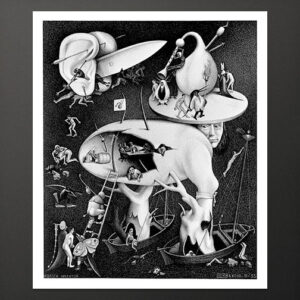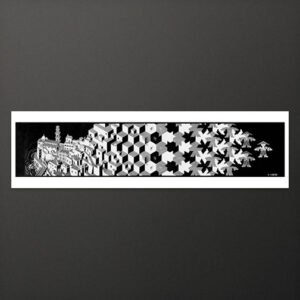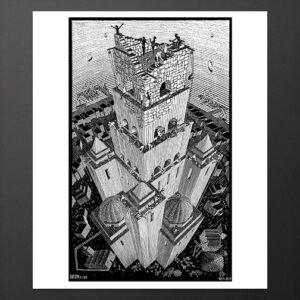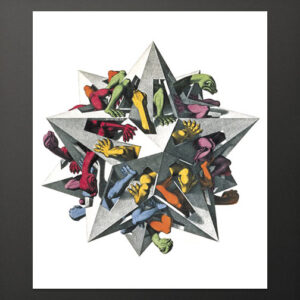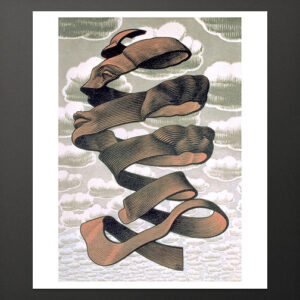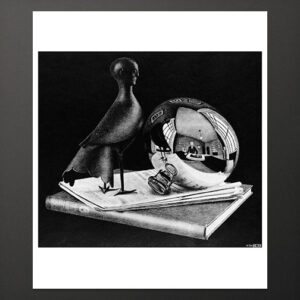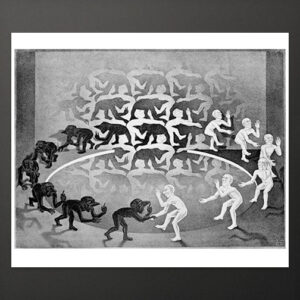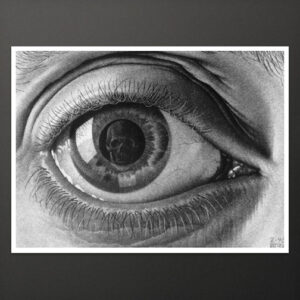-
Printed in black and white on 170gram paper. Packaged in cardboard tube. Paper size : 55 x 65 cm. Image size approx : 44 x 51,7.
-
Tower of Babel, woodcut, 1928. "It was assumed that the different races also emerged during the confusion of tongues; hence some construction workers are white, others black. The work has come to a standstill because they no longer understand each other. Since the quintessence of the drama takes place at the top of the tower under construction, it was shown, as if in a bird's eye view, from above. This resulted in the need for a strong perspective shift downwards." ~ M.C. Escher, Grafiek en Tekeningen. Printed in black and white on 170 gram paper. Paper size : 55 x 65 cm. Image size approx : 32,3 x 52 cm. Packaged in cardboard tube.
-
Gravity, lithograph, hand-coloured, 1952. "Here is another star dodecahedron, bordered by twelve flat five-pointed stars. On each of these platforms lives a tailless monster with a long neck and four legs. Its torso is trapped under a five-sided pyramid with walls, each with an opening, through which the animal protrudes its head and legs. But the pointed end of a platform on which one animal lives is also the wall of the dungeon of one of its fellow sufferers. All these triangular ends therefore have the double function of a floor as a wall." ~ M.C. Escher, Grafiek en Tekeningen. Printed in color on poster paper. Paper size : 55 x 65 cm. Image size approx : 49 x 49cm. Packaged in cardboard tube.
-
Rind, wood engraving of 4 blocks printed, 1955. "Like the spiral skin of a fruit, like a hollow, fragmentary sculpture, a female effigy floats through space. The depth effect is enhanced by a cloud cover receding towards the horizon." ~ M.C. Escher, Grafiek en Tekeningen. Printed in color on 170 gram paper. Paper size : 55 x 65 cm. Image size approx : 37,7 x 55 cm. Packaged in cardboard tube.
-
Still life with Reflecting Globe, lithograph, 1934. "The same reflective sphere as depicted in Hand with Reflecting Sphere, but here from the side, like a bottle with a neck." ~ M.C. Escher, Grafiek en Tekeningen. Printed in black and white on 170 gram paper. Paper size : 65 x 55 cm. Image size approx : 50,5 x 44 cm. Packaged in cardboard tube.
-
Encounter, lithograph, 1944. "From the gray edges of a back wall, a complicated pattern of white and black human figures develops. Since people who want to live need at least a floor to walk on, one was designed for them, with a circular hole in it, so that, as much of the back wall as possible, remains visible. As a result, they are also forced to walk in a circle and meet each other in the foreground: a white optimist and a black pessimist, who shake hands." ~ M.C. Escher, Grafiek en Tekeningen. Printed in black and white on 170 gram paper. Paper size : 65 x 55 cm. Image size approx : 55 x 39,7 cm. Packaged in cardboard tube.
-
Hand with Reflecting Sphere, lithograph, 1935. "A reflective sphere rests on the hand of the draftsman. He sees a much more complete picture of his surroundings in that mirror than through direct observation, because he sees almost the entire space around him: four walls, floor and ceiling of his room are , albeit distorted, compressed into that disk. His head, more precisely: the point right between his eyes, is in the center. No matter how he turns, he remains the center ." ~ M.C. Escher, Grafiek en Tekeningen. Printed in black and white on 170 gram paper. Paper size : 55 x 65 cm. Image size approx : 35,2 x 52,7 cm. Packaged in cardboard tube.
-
Eye, mezzotint, 1946. "The artist has depicted his own eye here, greatly enlarged in a concave shaving mirror. The pupil reflects him who is looking at all of us." ~ M.C. Escher, Grafiek en Tekeningen. Printed in black and white on 170gram paper. Paper size : 55 x 40 cm. Image size approx : 43 x 32 cm. Packaged in cardboard tube.

